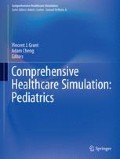Abstract
Scenario building, also referred to as scenario design, is a fundamental component of simulation-based medical education. When done effectively, the scenario can reliably meet the needs of the curriculum and the learners. This chapter explores the rationale for utilizing a formal scenario-building process, outlines many of the theoretical underpinnings important to the endeavor, and describes a practical, six-step approach to designing scenarios. Some of the topics explored in depth include curriculum design, teamwork/interprofessional education, fidelity/realism, the use of distraction, and confederates. The six-step approach involves identifying the target audience, learning objectives and simulator modalities, building a case summary, procuring staging needs (such as moulage, confederates, and adjuncts), writing the script, preprogramming the scenario where appropriate, and finally practicing or pilot-testing the scenario. A sample template is provided and common pitfalls are discussed.
Access this chapter
Tax calculation will be finalised at checkout
Purchases are for personal use only
References
Terrett L, Cardinal P, Landriault A, Cheng A, Clarke M. Simulation scenario development worksheet (Simulation Educator Training: course material). Ottawa: Royal College of Physicians and Surgeons of Canada; 2012.
McGaghie WC, Issenberg SB, Petrusa ER, Scalese RJ. A critical review of simulation-based medical education research: 2003–2009. Med Educ. 2010;44:50–63.
Holmboe E, Rizzolo MA, Sachdeva AK, Rosenberg M, Ziv A. Simulation-based assessment and the regulation of healthcare professionals. Simul Healthcare. 2011;6:S58–S62.
Khan K, Pattison T, Sherwood M. Simulation in medical education. Med Teach. 2011;33:1–3.
McGaghie WC, Siddall VJ, Mazmanian PE, Myers J. Lessons for continuing medical education from simulation research in undergraduate and graduate medical education: effectiveness of continuing medical education: American College of Chest Physicians Evidence-Based Educational Guidelines. Chest. 2009;135:62S–8S.
Cook DA, Brydges R, Zendejas B, Hamstra SJ, Hatala R. Technology-enhanced simulation to assess health professionals: a systematic review of validity evidence, research methods, and reporting quality. J Assoc Am Med Coll. 2013;88:872–83.
McGaghie WC, Issenberg SB, Cohen ER, Barsuk JH, Wayne DB. Does simulation-based medical education with deliberate practice yield better results than traditional clinical education? A meta-analytic comparative review of the evidence. J Assoc Am Med Coll. 2011;86:706–11.
Issenberg SB, McGaghie WC, Petrusa ER, Lee Gordon D, Scalese RJ. Features and uses of high-fidelity medical simulations that lead to effective learning: a BEME systematic review. Med Teach. 2005;27:10–28.
Norman G, Dore K, Grierson L. The minimal relationship between simulation fidelity and transfer of learning. Med Educ. 2012;46:636–47.
Lisko SA, ODell V. Integration of theory and practice: experiential learning theory and nursing education. Nurs Educ Perspect. 2010;31(2):106–8.
Maran NJ, Glavin RJ. Low- to high-fidelity simulation—a continuum of medical education? Med Educ. 2003;37:22–8.
Dieckmann P, Gaba D, Rall M. Deepening the theoretical foundations of patient simulation as social practice. Simul Healthc. 2007;2:183–93.
Rudolph JW, Simon R, Raemer DB. Which reality matters? Questions on the path to high engagement in healthcare simulation. Simul Healthc. 2007;2:161–3.
Cheng A, Lang TR, Starr SR, Pusic M, Cook DA. Technology-enhanced simulation and pediatric education: a meta-analysis. Pediatrics. 2014;133:e1313–23.
Hamstra SJ, Brydges R, Hatala R, Zendejas B, Cook DA. Reconsidering fidelity in simulation-based training. J Assoc Am Med Coll. 2014;89:387–92.
Brydges R, Carnahan H, Rose D, Rose L, Dubrowski A. Coordinating progressive levels of simulation fidelity to maximize educational benefit. 2010. J Assoc Am Med Coll. 2010;85:806–12.
Cooper SJ, Cant RP. Measuring non-technical skills of medical emergency teams: an update on the validity and reliability of the Team Emergency Assessment Measure (TEAM). Resuscitation. 2014;85:31–3.
Glavin RJ, Maran NJ. Integrating human factors into the medical curriculum. Med Educ. 2003;37:59–64.
Flin R. Identifying and training non-technical skills for teams in acute medicine. Qual Safe Health Care. 2004;13:i80–i4.
Rudolph JW, Simon R, Raemer DB, Eppich WJ. Debriefing as formative assessment: closing performance gaps in medical education. Acad Emerg Med. 2008;15:1010–16.
Hoffman DR. An overview of concurrent engineering. Reliability and maintainability symposium. 1998. doi:10.1109/RAMS.1998.653529.
Gilbert JHV, Yan J, Hoffman SJ. A WHO report: framework for action on interprofessional education and collaborative practice. J Allied Health. 2010;39(Suppl 1):196–7.
Cheng A, Donoghue A, Gilfoyle E, Eppich W. Simulation-based crisis resource management training for pediatric critical care medicine: a review for instructors. Pediatr Crit Care Med. 2012;13:197–203.
van Merriënboer JJG, Sweller J. Cognitive load theory in health professional education: design principles and strategies. Med Educ. 2010;44:85–93.
Paas F, Renkl A, Sweller J. Cognitive load theory and instructional design: recent developments. Educ Psychol. 2003;38:1–4.
Fraser K, Ma I, Teteris E, Baxter H, Wright B, McLaughlin K. Emotion, cognitive load and learning outcomes during simulation training. Med Educ. 2012;46:1055–62.
Cheng A, Auerbach M, Hunt EA, Chang TP, Pusic M, Nadkarni V, Kessler D. Designing and conducting simulation-based research. Pediatrics. 2014;133:1091–101.
Author information
Authors and Affiliations
Corresponding author
Editor information
Editors and Affiliations
Rights and permissions
Copyright information
© 2016 Springer International Publishing Switzerland
About this chapter
Cite this chapter
Huffman, J., McNeil, G., Bismilla, Z., Lai, A. (2016). Essentials of Scenario Building for Simulation- Based Education. In: Grant, V., Cheng, A. (eds) Comprehensive Healthcare Simulation: Pediatrics. Comprehensive Healthcare Simulation. Springer, Cham. https://doi.org/10.1007/978-3-319-24187-6_2
Download citation
DOI: https://doi.org/10.1007/978-3-319-24187-6_2
Published:
Publisher Name: Springer, Cham
Print ISBN: 978-3-319-24185-2
Online ISBN: 978-3-319-24187-6
eBook Packages: MedicineMedicine (R0)

